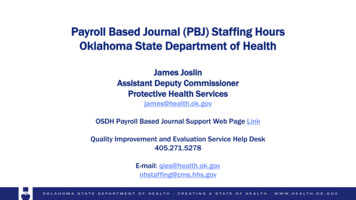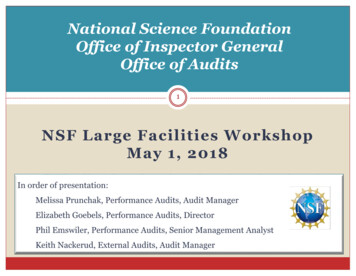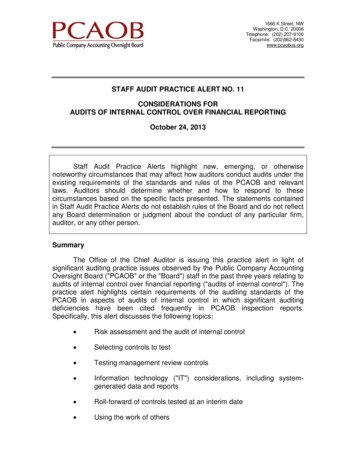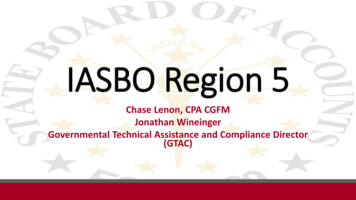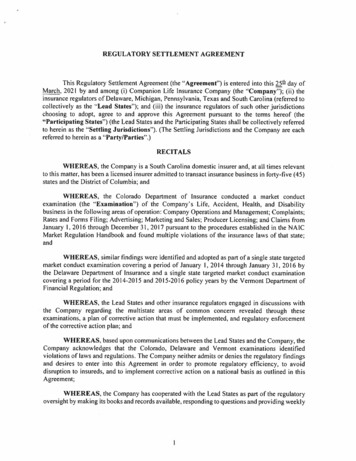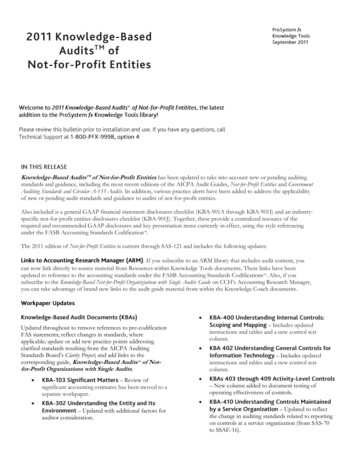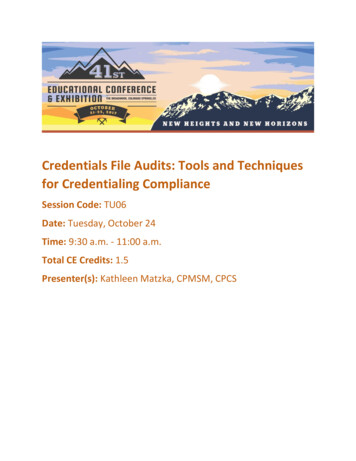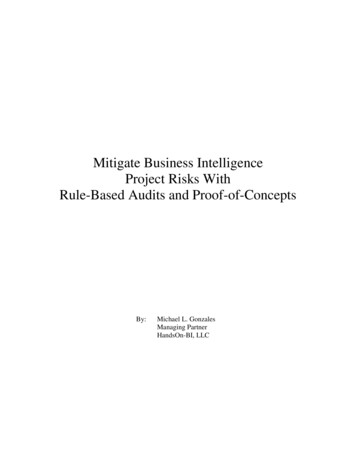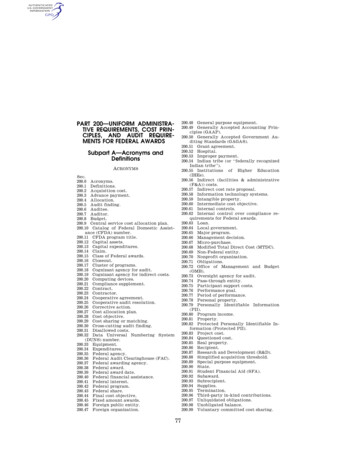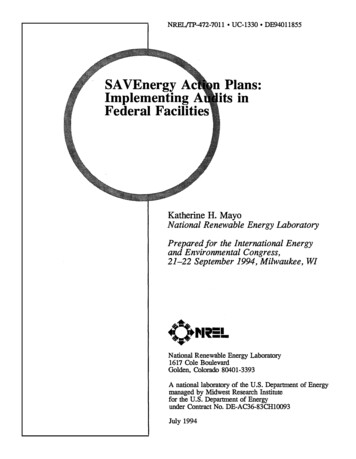
Transcription
NREL!IP-472-7011SAVEnergy AImplementing AFederal Facilities UC-1330 DE94011855Plans:ts inKatherine H. MayoNational Renewable Energy LaboratoryPrepared for the International Energyand Environmental Congress,21-22 September 1994, Milwaukee, WIN ati.onal Renewable Energy Laboratory1617 Cole BoulevardGolden, Colorado 80401-3393A national laboratory of the U.S. Department of Energymanaged by Midwest Research Institutefor the U.S. Department of Energyunder Contract No. DE-AC36-83CH10093July 1994
NOTICEThis report was prepared as an account of work sponsored by an agency of the United States government.Neither the United States government nor any agency thereof, nor any of their employees, makes anywarranty, express or implied, or assumes any legal liability or responsibility for the accuracy, completeness,or usefulness of any information, apparatus, product, or process disclosed, or represents that its use wouldnot infringe privately owned rights.Reference herein to any specific commercial product, process, orservice by trade name, trademark, manufacturer, or otherwise does not necessarily constitute or imply itsendorsement, recommendation, or favoring by the United States government or any agency thereof. Theviews and opinions of authors expressed herein do not necessarily state or reflect those of the UnitedStates government or any agency thereof.Available to DOE and DOE contractors from:Office of Scientific and Technical Information (OSTI)P.O. Box62Oak Ridge, TN37831(615) 576-8401Prices available by callingAvailable to the public from:National Technical Information Service (NTIS)U.S. Department of Commerce5285 Port Royal RoadSpringfield, VA 22161(703) 487-4650::.-Printed on paper containing at least 50% wastepaper and 10% postconsumer waste
SA VEnergy ACTION PLANS:IMPLEMENTING AUDITS IN FEDERAL FACILITIESKatherine H. Mayoimplement the Federal energy management portion ofABSTRACTEPACT and the entire Executive Order.6 One progmmwithin FEMP, the SAVEnergy Action Plan, has beenThe Department of Energy's Federal Energy ManagementProgram is charged with implementing key sections of theEnergy Policy Act of 1992 and all of the Executive Order12902, to make the Federal Government opemte moreenergy and water efficient. A congressionally-mandatedenergy, renewables, and water conservation audit programis one component of this plan. The SAVEnergy Actiondeveloped over the last year to support energy managers inmeeting their statutory goals through energy, renewables,and water conservation audits.EXECUTIVE ORDERWhile EPACT sets up the mechanism for audit teams, thePlan is designed to help energy managers identify specificExecutive Order states specific requirements and due datesenergy and water projects and link these projects tofundingappropriatemechanismsforfor completing energy, renewables, and water conservationaudits and implementing resulting recommendations.implementation.FEMP's SAVEnergy staff has been working with egislatively-mandated goals, both through FEMP'sprograms and other progmms available to the FederalCompleting AuditsAgencies must first perform a prioritization survey of theirfacilities to identify which sites have the most energyefficiency and water conservation savings potential.' Then,sector.based on the survey results, agencies must audit 10% oftheir facilities each year until all facilities have beenaudited. To accomplish this goal, agencies are allowed toINTRODUCTIONThe Energy Policy Act of 1992 (EPACT)1 gnificantly impact Federal energy management.thatuse previously conducted audits (within the last three years)and they are asked to develop a ten-year plan outlining theA goalof 20% energy reduction from the 1985 baseline by theyear 2000 was mandated for all agencies.procedure for audits of the remaining facilities.8Building onEPACT, the Executive Order 129022 was signed in MarchWith FEMP staff facilitating, the Intemgency EnergyManagement Task Force9 has assembled numerousworking groups, one of which is working to implement the1994 to give Federal energy managers tools and processesnecessary to implement energy efficiency, waterNow energyconservation and renewable measures.managers have specific action items and target dates whichshould enable them to reduce their gross square foot energyconsumption 30% by the year 2005, as is required by theaudit and implementation portions of the Executive Order.The working group identifies barriers to completingrequirements and makes implementation recommendationsfirstExecutive Order.3tothe entire Task Force,(AssistantSecretarythenThe following discussion focuses on the provision set forthin EP ACT for the establishment of energy audit teams4 andthe follow-up activities put forth in the Executive Order tohas supplied this handbook to all agencies.The energy ncyworking group hasidentified numerous methods to complete energy audits andaudit Federal facilities and implement the recommendedprojects.5 The Department of Energy's Federal EnergyManagement Program (FEMP) has been tasked toImplementing AuditsAs audits are completed, agencies must begin to implementthe1energyefficiencyandwaterconservation
recommendations within 180 days of the audit.11 Theenergy audit working group has established guidelines thatAction Plan is presented to this Action Team, composed ruction, and environmental personnel within theagencies can use in developing their 10-year audit andimplementation plans so that they can connect thesemilestones. These guidelines include: how to identifysignificant energy efficiency and waterconservationfacility or agency. This group would then work together todecide how to implement the Action Plan.Alldepartments that would impact project completion would. opportunities, how to self-audit or identify an auditor, andhave a "buy-in" and would be included in the process.how to acquire project funding. The SAVEnergy ActionOnce an Action Team is set up and begins implementingPlan is one means for the agencies to incorporate all ofprojects, that team will move on to additional work withinthese ideas.their agency, or even be called upon as a resource for otherSAVENERGY ACTION PLANSagencies. Empowering the agencies to solve their internalissues can only increase the effectiveness of the energymanagement programs at their facilities.The SAVEnergy Action Plan program was developed byFEMP to break the audit paradigm. The majority of auditsare conducted by energy service companies or architect andengineer (A&E) fmns and presented with an g and cost calculations.mustdecidewhenandifandFUNDING SOURCESWith energy budgets under close scrutiny, Federal agencieshave been encouraged to leverage funding from as manydetailedThe facility managernon-Federal resources as possible.toAction Plan is tailored to the expected funding source for ,implementtheEach SAVEnergyprojects.recommendations. The SAVEnergy Action Plans have builta follow-up mechanism into the process.Private SectorUtility DSM programs and energy service companiesAudit ProtocolBased for the most part on statutory requirements, the(ESC0s)15 can finance projects for the Federalgovernment that are not able to be funded by an agency.Where a free energy audit is offered by a utility, AgenciesSAVEnergy program has a set protocol to which everyaudit conducted in the SAVEnergy program must adhere.These requirements include: Federal life cycle costing/2maximum 10-year simple payback for projects, renewableare encouraged to take advantage of the service. The auditmust be fuel-neutral and should give specific projectrecommendations. If the audit is not comprehensive orenergy and water conservation screening, fuel-neutrality,familiarity with funding resources, and the development ofa SAVEnergy Action Plan for project implementation. Thedoes not meet Federal standards, the SAVEnergy programagency must sign a letter of agreement stating acommitment to completing recommended projects.Athe use of any available DSM funds for projects.savings verification plan must also be developed to helpensure that projected savings are achieved. Thus, theWhere agencies have no project funds, private sectorcan complete a comprehensive audit and still recommendprotocol has built into the audit follow-up and successindicator processes.13leveraging is encouraged. When the agency is interested inbringing in an ESCO to fund a project, a SAVEnergy auditwill take on the characteristics of a walk-through audit,Project Implementationproviding general utility and operational data to enable thefacility manager to give consistent information to biddingThe SAVEnergy Action Plan for project implementation isESCOs. Recently, due in part to FEMP's emphasis onwritten so that energy managers have all of their potentialEnergy Savings Performance Contracting (ESPC), Federalfunding options identified so that project implementationagencies have found it easier to makecan move forward. For example, if an auditor recommendsthat a utility demand side management (DSM) programshould be used to help fund a lighting retrofit project, thecontracts effective in the government.performanceFederal FundsAgencies who have their own audit and project funds maytake advantage of the SAVEnergy comprehensive auditauditor will have all of the required utility forms filled outfor the agency representative to sign. Even with veryprogram, with FEMP co-funding the audit. At a minimum,the SAVEnergy program could provide audit protocol andprocess information to enable the agency to complete itsspecific guidance on funding options and projects, anagency may have trouble in implementation due to internalbarriers.own audit or to help the agency in obtaining a quality audit.FEMP has piloted the use of a SAVEnergy Action Team toovercome the variousobstacles.14For agencies who have very little of their own funds, butThe SAVEnergy2
have identified innovative and high potential projects,FE:MP has a grant program, the Federal Energy EfficiencyENDNOTESFund (Fund)16 which can finance both a comprehensivel.SAVEnergy audit and project implementation. The Fundis currently available to all agencies except the Departmentof Defense, Department of Energy, the V eteran's2.Administration, and the General Services Administration.These agencies receive dedicated appropriations for fundingenergy projects.3.4.5.Now that the SAVEnergy Action Plan program has beendeveloped and has started work, the constant qualityassurance process is beginning. The goal is that, once a6.certain number of audits are conducted, agencies will havea better understanding of their facilities, in general, and7.8.therefore will be able to transfer completed projects tomany other sites. The agencies should also be able tocomplete audits and facilitate projects much easier withestablished processes.FE:MP wants the SAVEnergy9.The Energy Policy Act of 1992 (EPACT) P.L.l 02 486.Executive Order 12902-Energy Efficiency and WaterConservation at Federal Facilities, March 10, 1994.Executive Order, Sec. 301, Energy ConsumptionReduction Goals.EPACT, Sec. 158(a),Establishment of Energy AuditTeams.Executive Order, Sec. 302,Energy and Water Surveysand Audits, Sec. 303, Implementation of EnergyEfficiency and Water Conservation Projects.Executive Order, Sec. 201, Interagency Coordination.Executive Order, Sec. 302(a), Prioritization Survey.Executive Order,Sec. 302(b), Comprehensive anagementTask Force.program to serve as a model for Federal energy and water10. EPACT, Sec. 151(4), "Task Force," Executive Order,Sec. 201, Interagency Coordination.audits, positioning agency audit activities to be self sustaining and of high quality with private sector delivery.11. Executive Order, Sec. 303(a), Implementation of NewAudit Recommendations.12. EPACT, Sec. 544(b), Use of Life Cycle Cost MethodsIn part, FE:MP's mission is to support the Federal energyand Procedures.13. Energy and Water Conservation Action Plan Protocol,FE:MP.14. SAVEnergy Action Team pilot program at SocialSecurity Administration, Baltimore, Maryland.15. EPACT, Sec. 801(a),ESPC.16. EPACT, Sec. 546(b)(1), Federal Energy EfficiencyFund.manager and to develop programs which will allow theFederal Government to create better energy and water usepractices to make energy efficiency and renewables, notsubsidized programs, but the way to do business.ACKNOWLEDGEMENTSMark Ginsberg, Federal Energy Management ProgramRobert Westby,Ellen Morris, National Renewable EnergyLaboratory3
EP hs a ant poam, the Federal Energy Eficiency Fund Fund)16 which n ance boh a comprehensive SA VEnergy audit and project implemenaion. The Fund is curently available to all agencies except the Deptment of Defense, Depment of Energy, he Veean's Adminisaion, nd the Genal Services Adminisraion.

